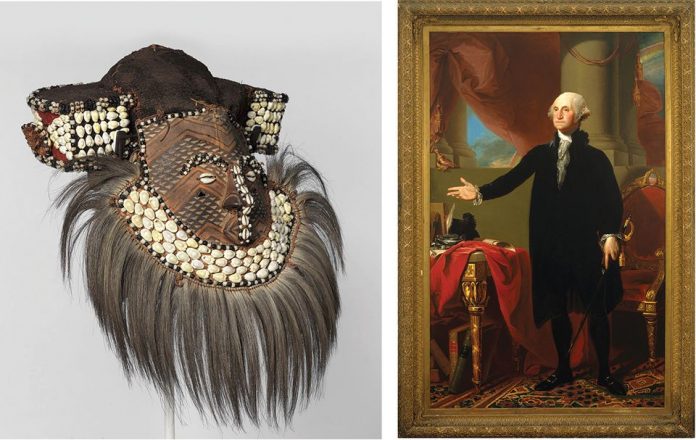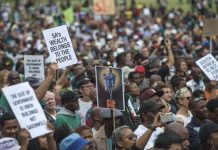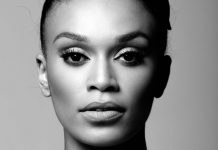A Kuba mask from central Congo staring right at America’s founding father, George Washington, is a poetic faceoff that rings true now more than ever. Two of the works being exhibited at the Brooklyn Museum as African Arts—Global Conversations opened 14th of February, it is a juxtaposition of two different cultural ideals that share a common purpose.
Kristen Windmuller-Luna, former curator of African arts at the Brooklyn Museum, and the organiser of African Arts–Global Conversations says, “the mask depicting a onetime Kuba leader, dating from the late 19th or early 20th century, evokes wealth and status through its cowrie shells, which were a kind of currency in the Kuba kingdom of the central Congo, while the rainbow in the Washington portrait symbolises the peace and prosperity ushered in after the American Revolution.”
African Arts—Global Conversations puts African arts where they rightfully belong: within the global art historical canon. It brings those works into greater, meaningful art historical conversations and critiques previous ways that encyclopedic museums and the field of art have or have not included them.
Though the positioning of the works opposite each other is not to draw lines between what they stand for, the thought of it comes to mind. Have these ideals been able to survive centuries of transcultural exchange? Do they even matter anymore when the world is already at the fingertips and one could assume any ideal of choice at an insta-second?
The exhibition’s distinctive transcultural approach pairs diverse African artworks across mediums with others from around the world. By considering how shared themes and ideas—such as faith, origins, modernism, and portraiture—originated in different parts of the world, it provides new theories for discussing African arts in relation to non-African arts.
African Arts—Global Conversations will present thirty-three works, including twenty by African artists, and will run through November 15, 2020. Highlights include a celebrated eighteenth-century Kuba sculpture, fourteenth- to sixteenth-century Ethiopian Orthodox processional crosses, and a mid-twentieth-century Sierra Leonean Ordehlay or Jollay society mask. Also featured are recent works by Atta Kwami, Ranti Bam, Magdalene Odundo OBE, and Taiye Idahor, which are paired with artworks by Māori, Seminole, Spanish, American, Huastec, and Korean artists.






